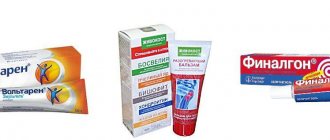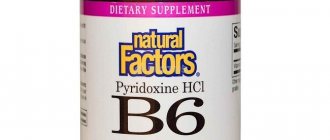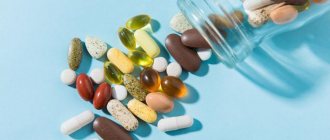Types and forms of preparations for joints and ligaments
To treat joint diseases in which damage to cartilage and muscle tissue occurs, doctors prescribe complex therapy. It includes the use of several groups of drugs with systemic and symptomatic action, which make it possible to influence the cause, relieve symptoms, thereby improving the general condition of the patient.
The choice of medication and the duration of its use depend on the main diagnosis, but in any case you need to trust your doctor.
In practice, the following types of drugs are most often used:
- Analgesics.
- Non-steroidal anti-inflammatory drugs.
- Antirheumatic.
- Chondroprotectors.
- Corticosteroids.
- Muscle relaxants.
- Vitamin complexes.
Such medications are produced in different forms: tablets, ointments, gels, ampoules for intramuscular or intra-articular administration. They contain various active components that help stop pathological processes, reduce symptoms, and eliminate progression and possible complications. Let's consider several groups of drugs that are widely used in the treatment of diseases of the joints and periarticular tissues.
Painkillers
Almost all diseases of the musculoskeletal system are accompanied by pain, which can be of varying intensity and localization, but significantly worsens a person’s overall well-being and reduces the quality of life. To eliminate pain, doctors prescribe painkillers (analgesics).
Based on their composition and mechanism of action, they are divided into 3 groups:
- Non-narcotic analgesics. They relieve pain of varying intensity and are not addictive. They act in the affected area, relieve inflammation, pain, and swelling of soft tissues. Effective for 4–8 hours. Common medications include Xefocam, Ketanov, Analgin, Aspirin, Larfix and others.
- Opioid medications. They are potent drugs for eliminating joint pain. One of the most effective is Nalbuphine, which is not addictive, but is available in pharmacies only with a doctor’s prescription.
- Narcotic. A group of medications used to relieve severe pain or when other pain medications do not provide the desired effect. Taking such drugs requires strict medical supervision, since they have many contraindications and side effects, and with long-term use they are addictive: Tramadol, Morphine, Oxycodone and others.
Non-steroidal anti-inflammatory drugs
Drugs from the group of nonsteroidal anti-inflammatory drugs (NSAIDs) have become widespread in the treatment of joint diseases. Taking them not only relieves pain, but also eliminates the inflammatory process that is present in a large number of diseases of the ligaments and joints. Common ones include:
- Ibuprofen.
- Diclofenac.
- Nimesulide.
- Ketoprofen.
- Ketolorac.
- Movalis.
- Meloxicam.
- Celecoxib.
The duration of taking medications from this group should not exceed 5–14 days. They have their own contraindications and side effects, which you need to familiarize yourself with before use.
DMARDs
A large group of drugs includes disease-modifying antirheumatic drugs (DMARDs), which not only relieve pain and inflammation in rheumatoid arthritis, but also slow down the progression of the disease and minimize its possible complications.
- Cyclophosphamide.
- Cyclosporine (Sandimmune).
- Hydroxychloroquine (Plaquenil).
- Leflunomide (Arava).
- Methotrexate (Trexal).
Such drugs have specific anti-inflammatory and immunosuppressive activity and can only be prescribed by a doctor.
Chondroprotectors
To strengthen and eliminate the risk of destruction of cartilage tissue, drugs from the group of chondroprotectors are prescribed. These medications contain glucosamine and chondroitin sulfate, which have the ability to eliminate the inflammatory process, enhance the production of synovial fluid, and protect cartilage from excessive friction and destruction. Drugs from the group of chondroprotectors include:
- Artron.
- Mucosat.
- Chondroxide.
- Arteparon.
- Teraflex.
A good effect can also be obtained from the drug Alflutop, which contains marine fish extract with glycosaminoglycans. Its use improves metabolic processes in cartilage tissue and stimulates its restoration.
It is recommended to take chondroprotectors for a long time. The effect of treatment can be noticed in the early stages of the disease. When the destruction of articular surfaces and cartilage has occurred, the effect of such drugs will be insignificant.
Glucocorticosteroids
In case of severe inflammation or when NSAIDs do not bring the desired result, the doctor prescribes glucocorticosteroids. Their use eliminates inflammation and reduces pain.
- Hydrocortisone.
- Methylprednisolone.
- Diprospan.
- Celeston.
Available in the form of injection ampoules. Both blockades can be administered intra-articularly and intramuscularly. Drugs from the group of glucocorticosteroids can be prescribed in short courses and only as prescribed by a doctor.
Topical preparations
Complex therapy of joint diseases includes the use of local agents. They are produced in the form of ointments, gels, and solutions. It contains components that help relieve pain and inflammation. Some ointments contain natural ingredients that have a warming property. The most popular are:
- Fastum-gel.
- Apizartron.
- Diclofenac.
- Capsicam.
- Voltaren gel.
It is recommended to apply ointments to the area of inflammation 2 times a day. Indications for their use include arthritis, arthrosis, osteochondrosis, sprains and other diseases.
Recipes for restoring cartilage tissue
Restoration of cartilage tissue must begin with nutritional correction: include foods containing lysine in the diet. It is this component that is responsible for the integrity and strength of cartilage.
It is found in the following products:
- gelatin;
- dried apricots;
- prunes;
- eggs;
- spinach.
You can also prepare remedies at home that help restore and strengthen cartilage tissue.
Gelatin
The recipe consists of the following sequential steps:
- Dissolve 2 tsp in 50 ml of water. gelatin.
- Let it soak overnight.
- In the morning on an empty stomach, eat the resulting jelly. For taste, you can add fruit puree or jam.
Chicken cartilage
Chicken cartilage is very healthy due to its high collagen content.
Recipe:
- Cook 1 kg of chicken cartilage for 2-3 hours.
- Add salt and pepper to taste.
- Add 1.5 liters of hot water.
- Cool.
- Take a glass 2-3 times a day.
Golden mustache
This plant is very valuable in folk medicine due to its ability to restore cartilage tissue.
Recipe for making ointment:
- Squeeze the juice from the plant.
- Mix it with Vaseline or fatty cream in a 1:1 ratio.
- Rub into the area of damaged joints 2-3 times a day.
- It is possible to apply compresses with this composition.
Eggshell
The calcium contained in egg shells makes it a valuable component for bones, joints and cartilage.
How to use:
- Remove the shells from raw, washed eggs.
- Grind them into crumbs.
- Add 5 g per day to food.
If problems with cartilage or joints are detected, you should consult a general practitioner for diagnosis. Identified problems require treatment, including drug therapy, physical exercise, external care measures and supporting the body with vitamins.
Article design: Oleg Lozinsky
Elimination of pain symptoms
In case of joint diseases and injuries, the main symptom is pain, which can have varying intensity, bother a person for periods or be present constantly. The appearance of pain significantly reduces a person’s quality of life and is often a reason to consult a doctor.
Drugs that help relieve pain are classified as symptomatic drugs. They are available in different pharmacological forms: tablets, injections, ointments. Such medications often contain diclofenac, nimesulide, triamcinolone acetonide and other components that help relieve pain and improve the general condition of the patient.
Preparations for joints and bones
Diseases of the joints and bones have different etiologies, so therapy should correspond to the main diagnosis and the stage at which the disease is located. Such diseases are divided into the following groups:
- Dystrophic lesions – osteoporosis, arthrosis, arthritis.
- Inflammatory – osteomyelitis, rheumatoid arthritis.
- Injuries – dislocations, sprains, cracks, bone fractures.
- Degenerative processes – osteoarthritis, ankylosing spondylitis.
- Tumors of the musculoskeletal system.
Depending on the diagnosis, the doctor individually prescribes therapeutic therapy, which consists of taking several groups of drugs:
- Anti-inflammatory drugs.
- Analgesics.
- Corticosteroids.
- Chondroprotectors.
- Muscle relaxants.
- Vitamins for joints.
The choice of a specific drug, dose and duration of therapy are prescribed by the doctor based on the diagnosis, stage of the disease, age of the patient and characteristics of his body.
Preparation for ligaments and cartilage
Not only joints and bones are susceptible to pathological processes. Periarticular tissues are also often affected: ligaments, cartilage tissue. It's not just the joints that need therapy. Ligaments and connective tissues are often affected. The cause can be either injury or progressive disease.
Basically, doctors prescribe drugs for ligaments in the form of ointments, gels or rubs, which have a local effect, improve blood circulation, and eliminate pain. Medicines that contain the following components also bring benefits:
- Glucosamine.
- Chondroitin.
- Collagen.
- Vitamin D and calcium.
There are many drugs containing these components on the pharmaceutical market, but the choice should always be agreed with your doctor.
How to choose vitamins
Preference should be given to those drugs that have been used for a long time and have received many positive reviews. Recommendations can be obtained from your trainer or physician. In addition, you need to thoroughly study the features of the active components of additives and carefully read the composition when choosing them. Now the pharmacological industry produces various vitamins for the joints and ligaments of athletes. How to choose the best drug?
- You should not purchase supplements that contain too many different ingredients, as many vitamins and minerals can interact with each other, causing an adverse effect.
- Preference should be given to drugs that do not contain flavors, dyes, or other substances that can cause allergic reactions.
- Pay attention to the amount of active ingredients in the supplement.
- Vitamin supplements are available in tablets, powders, capsules, and even injections. You need to choose those that are convenient to take.
- Before taking any drug, even on the recommendation of a doctor, you should carefully study the instructions, which describe all contraindications and side effects.
Vitamins to strengthen joints and bones
To maintain the functioning of the skeletal system and reduce the risk of joint diseases, it is recommended to provide the body with vitamins for joints and bones. Most of them are found in food, but if this is not enough, it is recommended to use special multivitamin complexes or supplements. The following vitamins will benefit joints and bones:
- A – antioxidant, stimulator of calcium and phosphorus metabolism in the body.
- B1 (thiamine) – slows down the aging of cartilage tissue, takes part in metabolic processes. Thiamine is not synthesized by the body, so it must be obtained from food or vitamin complexes. Thiamine deficiency causes paresis of the limbs, muscle atrophy, increases the risk of joint diseases and damage to tendons and ligaments.
- B5 (pantothenic acid) - a stimulator of glucocorticoids in the body, reduces the risk of developing arthritis. A lack of this vitamin causes muscle and joint pain.
- B6 – normalizes salt and mineral metabolism.
- D – strengthens bones and joints, cleanses blood vessels, helps eliminate pathological changes in the skeletal system.
- E – increases the production of joint fluid, helps restore cartilage tissue.
- PP – improves joint mobility.
In addition to vitamins, the body also needs minerals: zinc, selenium, potassium, copper and other nutrients.
Calcium and vitamin d
Vitamin D and calcium are two elements that play an important role in many biological processes in the body. Calcium is considered the building material of the musculoskeletal system. It strengthens bones, increases their density, and reduces the risk of developing osteoporosis.
Vitamin D improves the absorption of calcium, so both components should enter the human body at the same time. Vitamin D is necessary for normal mineralization and growth of bones, proper functioning of the nervous and muscular systems.
There are several drugs that contain calcium and vitamin D:
- Calcium d3 Nycomed.
- Complements calcium D3.
- Natekal D3.
Taking the complexes allows you to meet the body’s daily needs with these components, strengthen joints, and reduce the risk of pathological changes.
Fatty acid
Polyunsaturated fatty acids are not synthesized by the human body, but they participate in many biological processes and improve the functioning of internal organs and systems. The main representatives of fatty acids are omega-3 (docosahexaenoic, alpha-linolenic, eicosapentaenoic acids) and omega-6 (arachidonic, linoleic acids). Common medications containing fatty acids include:
- Solgar Omega-3.
- Doppelhertz Active Omega-3.
- Aquamarine Omega-3 from Vitabiotics.
- Fish oil Unique Omega-3.
Polyunsaturated fats support the functioning of cell membranes, relieve inflammation, increase immunity, and improve the rheological properties of blood. They can be taken in combination with other vitamins or medications for the treatment of joints.
Vitamins for professional athletes
Considering that athletes’ workloads significantly exceed the average, their metabolism proceeds faster and it is important to choose vitamins that strengthen joints and protect them from injuries and damage. It is also necessary to protect the cartilage, because it is they that neutralize impacts and soften sharp turns.
Athletes choose vitamin formulations that prevent premature wear of joints and cartilage. Biological supplements are necessary for restoring joints after exercise and feeding them with the necessary nutrients.
Regular intake of vitamin supplements protects intervertebral discs.
The main criteria for choosing vitamins for athletes:
- Age;
- Load level;
- Presence of diseases;
- Condition of the musculoskeletal system.
Weightlifters and athletes who have been injured require special attention and undergo rehabilitation therapy.
Vitamins should provide the body with the necessary building material for the regeneration of muscle fibers, elimination of microtraumas and treatment of joint pathologies.
All athletes, regardless of age, type of sport and degree of stress, need the following vitamins:
- Chondroitin and glucosamine are the basis of cartilage tissue, stimulate the synthesis of synovial fluid, with regular use, crunching in the joints disappears, fatigue is felt less, joints recover faster after training;
- Methylsulfomethane - the substance is a source of sulfur, indispensable for injuries for the rapid restoration of motor activity;
- Collagen – restores joints and cartilage;
- Omega-3 - healthy fats present in fish oil and vegetable oils, increase the elasticity of joints, reduce the likelihood of injuries and inflammatory processes.
What vitamins do joints and ligaments need for recovery?
With the right choice of vitamins, they can not only reduce the risk of joint diseases, but also speed up recovery and enhance the effect of taking other medications. When choosing vitamins for joint pain, attention should be paid to preparations with a sufficient content of vitamin A, group B, C, D, E; it is also important that the composition contains selenium, phosphorus, calcium, magnesium and other substances. If a person is involved in active sports, you should buy supplements with proteins, glucosamine and other elements that will help maintain energy metabolism. In old age or with chronic joint diseases, you should pay attention to vitamin and mineral complexes containing chondroitin, glucosamine, and folic acid.
We suggest studying the rating of the best vitamins for joints, which are most often prescribed by doctors for therapeutic and preventive purposes.
Doppelherz aktiv glucosamine chondroitin
Doppelhertz active Glucosamine + Chondroitin is a dietary supplement for the treatment and prevention of diseases of the musculoskeletal system. The drug is available in capsules for oral administration. Contains chondroitin sulfate – 100 mg and glucosamine sulfate – 750 mg, as well as auxiliary components.
- Glucosamine in the drug has a moderate anti-inflammatory and analgesic effect. Allows you to improve joint mobility, improves phosphorus-calcium metabolism in cartilage tissue, and slows down its destruction.
- Chondroitin enhances the therapeutic effect of glucosamine, reduces pain, and stimulates the production of synovial fluid.
The instructions for use of the drug indicate that you need to take the capsules once a day with a sufficient amount of water. The duration of treatment is 2 months. Indications for use are the treatment and prevention of degenerative-dystrophic lesions of the joints and spine. The drug has virtually no contraindications or side effects. The cost of the complex is about 500 rubles per pack of 30 capsules.
Calcemin Advance
Calcemin Advance is a regulator of phosphorus-calcium metabolism. The composition contains several active components:
- calcium – 500 mg;
- magnesium – 40 mg;
- vitamin D3 – 200 IU;
- copper – 1 mg;
- zinc – 7.5 mg;
- boron – 0.25 mg;
- manganese – 1.8 mg.
Microelements in Calcemin Advance have a complex effect on the body, helping to strengthen bones and joints. It is recommended to take during the period of active growth, for the treatment of osteoporosis, arthrosis, as well as during long-term use of glucocorticosteroids and immunosuppressants.
Daily intake should not exceed 1 tablet. The drug is contraindicated for children under twelve years of age. The price of the drug is about 450 rubles per pack of 30 tablets.
Complivit calcium D3
Complivit Calcium D3 is a complex vitamin preparation. Belongs to the group of regulators of calcium-phosphorus metabolism. Contains:
- calcium – 500 mg;
- vitamin D3 – 200 IU.
Prescribed during periods of intensive growth and development, indicated for women during pregnancy, and indicated for poor nutrition. Taking it helps reduce the risk of developing joint diseases and accelerates the healing process of bones after fractures. Take the vitamin 1 tablet 2 times a day. Duration of therapy is 1–3 months. The cost of the vitamin complex is about 200 rubles per package.
Arthritis
Arthritis is a herbal vitamin and mineral complex for the treatment and prevention of joint diseases. The rich composition allows for a wide therapeutic effect:
- normalize metabolic processes;
- enhances the production of synovial fluid;
- improves calcium absorption;
- relieves inflammation;
- reduces pain;
- restores cartilage tissue.
Taking Arthrivitis significantly reduces the need for painkillers. Prescribed for arthritis, arthrosis, injuries from injuries, or taken as a prophylactic during intense physical activity. The dose of the drug is determined by the doctor individually, but it should not exceed 2 tablets per day. Duration of treatment is up to two months.
Orthomol arthro plus
Orthomol Artro Plus is a vitamin complex that is designed for people suffering from joint diseases. The drug contains:
- chondroitin;
- glucosamine;
- hyaluronic acid;
- vitamins B, D;
- omega-3 polyunsaturated fatty acids.
The unique composition of the complex is selected in such a way that all components complement each other perfectly. Taking the drug allows you to protect joints and periarticular tissues from all kinds of pathological processes. Prescribed as a dietary supplement for arthritis, arthrosis and other conditions. It interacts well with other medications and has virtually no contraindications.
Complements chondro
Complivit Chondro is a dietary supplement for restoring cartilage tissue and improving joint mobility. The basis of the medicine is:
- chondroitin sulfate;
- glucosamine sulfate;
- microcrystalline cellulose;
- calcium hydrogen phosphate dihydrate;
- vitamin C;
- vitamin E.
Adults take 1 tablet 2 times a day. The course of admission is 6 months. Prescribed as a dietary supplement to food. It has no contraindications except for individual intolerance.
Vitamin E (tocopherol)
Another fat-soluble representative of the antioxidant complex. Its role is as multifaceted as the previous vitamins. Vitamin E plays an important role in the processes of reproduction - both at the stages of synthesis and maturation of germ cells, and in the early stages of embryo formation.
Tocopherol is also involved in collagen synthesis, prevents premature destruction of the hyaline membrane of joints, protects and stabilizes cell membranes.
The main sources of tocopherol are cold-pressed vegetable oils, nuts, seeds, wheat germ, eggs and liver.
With vitamin E, both in pure form and as part of supplements and complexes, you also need to be careful not to cause hypervitaminosis.
Which doctor will help in treating joints?
If you experience joint pain, do not hesitate to visit a doctor. The sooner a person seeks help from a specialist, the greater the chance of successful recovery. Doctors from several areas of medicine can treat diseases of the musculoskeletal system.
At the first signs of illness, you need to contact a therapist, who, after collecting an anamnesis, examination and examination results, will refer you to a specialist.
- Rheumatologist.
- Orthopedist.
- Traumatologist.
- Chiropractor.
- Infectious disease specialist.
- Neuropathologist.
Consultation with specialist doctors will help confirm or refute the primary diagnosis made by the therapist. After the final diagnosis is made, the patient undergoes treatment by one of the doctors.
Possible side effects of taking medications
Any pharmaceutical preparation for joints and ligaments, vitamin complex or dietary supplement has its limitations and possible side effects, which you need to familiarize yourself with before taking it. The risk of their development increases if the doses prescribed by the doctor are not followed or if there are contraindications. Symptoms of side effects directly depend on the form of release of the drug. So, when using local products, an allergic skin reaction may occur in the form of itching, burning or rash. When taking medications orally, the list of adverse reactions increases:
- nausea, urge to vomit;
- discomfort, stomach pain;
- muscle weakness;
- headache, dizziness;
- allergic manifestations;
- convulsions.
At the first discomfort, you need to stop treatment and seek medical help.
To avoid such symptoms, you need to take any medicine as prescribed by your doctor, strictly observing the dose and duration of treatment.
Vitamins that strengthen joints and periarticular tissues rarely cause adverse reactions in the body, but they should still be taken for therapeutic or preventive purposes after prior consultation with your doctor. It is important to understand that any joint disease requires complex therapy, which will consist not only of taking medications, but also a therapeutic diet, exercise therapy, physiotherapy and a healthy lifestyle.
Introduction[edit | edit code]
Supplements for joints (Boris Tsatsouline)
Restoration of joints. Facts and speculation. The effectiveness of chondroprotectors. Chondroitin and glucosamine (Boris Tsatsouline)
What to take for joints?
High physical loads on ligaments and joints lead to chronic pain and the development of degenerative processes in ligaments and joints. In addition, almost every athlete, even at the amateur level, faces various injuries, so it is very important to pay increased attention to their prevention. This is facilitated by both thorough warm-up and the use of special sports supplements, which accelerate the regeneration of connective tissue and help strengthen it. Any sport is characterized by a certain range of injuries. If you go to the gym, then the increased load falls on the joints and ligaments; they should be taken care of first.
Connective tissue[edit | edit code]
Connective tissue includes tendons, ligaments, muscle fascia, aponeuroses (fibrous membranes that connect muscles together or to bones) and is part of the lining of almost all organs. The main function of connective tissue is to create mechanical strength of the body and give it shape. Connective tissue consists mainly of collagen, which is strong protein threads that prevent tissue from tearing, and elastin, which provides elasticity and extensibility of tissues. Each type of connective tissue contains special cells - fibroblasts in ligaments and tendons, chondroblasts in cartilage, osteoblasts in bone. These cells produce elastin and collagen, and also promote the renewal and restoration of connective tissue.
Relevance[edit | edit code]
In order to achieve high results in bodybuilding, athletes have to exercise with heavy weights during training, since muscle growth requires creating a maximum load on each muscle bundle. With the constant increase in working weights, the risk of injury also increases, so it is necessary to further strengthen the ligaments and cartilage tissue of the joints.
Systematic trauma to cartilage leads to the development of osteoarthritis - a disease that is accompanied by severe pain in the joints, impaired motor activity and is practically irreversible, that is, it often leads to disability. About 20 million Americans suffer from this disease, and statistics show that the risk of this pathology is significantly higher when engaging in strength sports.
So if you:
- Are you into bodybuilding or powerlifting?
- You experience pain, crunching or stiffness in your joints and ligaments
- Got injured
- Do you want to strengthen your ligaments and joints?
Remember that diseases of the ligaments and joints are very difficult to treat, so prevention is much more effective! The recommendations in this article are devoted to prevention, and only secondarily to treatment. Preventive courses are especially relevant for people over the age of 30, when connective tissue becomes more vulnerable.
Criticism[edit | edit code]
Data from a network meta-analysis of controlled trials conducted in 3803 patients with osteoarthritis of the knee and hip joints failed to identify any clinically significant effect of glucosamine, chondroitin, or their combination in reducing joint pain or slowing joint space narrowing compared with placebo. From this it follows that neither chondroitin sulfate, nor glucosamine sulfate, nor their combinations help with joint pain.










